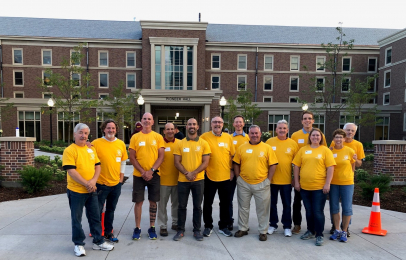By Matt Sutherland, AIA, Project Designer
In August 2019, I was given the opportunity to volunteer at Pioneer Hall’s student move-in day. I had spent the better part of the previous two years designing major renovations and an addition to the historic residence hall at the University of Minnesota’s Twin Cities campus. Sitting at my desk, I spent countless hours virtually walking through the building, meticulously drawing and measuring every space, developing every room for an overall goal to enhance student life.
The residence hall design looked and operated appropriately in 3D, the design plans transformed into a perfectly constructed building that was ready to welcome students, and the client was happy - but did that mean the project was done for me?
I found one of the most educational and enlightening aspects of this project for me was the ability to go back to Pioneer Hall in reality, instead of virtually, after the construction was complete. On student move-in day, I observed how the students interacted with the new space; I took note of how the space felt and even smelled, and I watched it functioning in real life.
The opportunity to visit the building was an awesome experience. We assisted students and their parents with lugging furniture and personal items to their new living quarters. I saw the students lining up for food in the dining hall and watched as they met their new roommates and entered the building for the first time.
By visiting, I gained a real-world perspective of Pioneer Hall that a trip through the hallways in virtual 3D could never have given me. I noticed the effects of design decisions that I imagined sitting at my desk in front of the computer.
I watched how students interacted in the designated lounge areas and overheard their excitement when they saw the reclaimed wood we incorporated into the lobby’s elegant design. I observed how natural light presented itself in each room and how the placement of each window or door affects that natural light. I even got to eat dinner in the dining hall for which I was a lead designer on the team. This was a particular treat for me.
I also took the opportunity to personally talk with students and their parents as they were moving into the building. One father mentioned that his daughter’s room was a nice fit for her because it had several windows and a bay window for all of the plants that she had brought from home. A mother said she and her son were in awe of the view of downtown Minneapolis from his room’s window. Other students and parents asked us questions about the building’s design and history, sparking conversations which I really enjoyed.
The lessons I learned during the student move-in day are invaluable to my profession as an architect. I don’t always get the opportunity to return to a building once the construction is complete, so I would like to thank the university personally for allowing me to do so. I would also encourage other universities to allow their architects to tour the facilities they design after construction is complete. I think it is extremely valuable for future design.
I had been living Pioneer Hall’s design in my head for so long in the virtual world, then watched it being built for a period of over a year. As an architect you want everything in the right place and functioning properly. When I returned to the completed Pioneer Hall and saw the lights on, felt the air conditioner running, smelled the food and saw the happy students, I knew that everything had worked out beautifully. Moreover, I am very proud of the positive influence Pioneer Hall will have on future generations of students.





